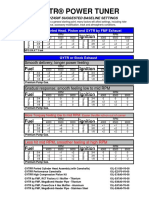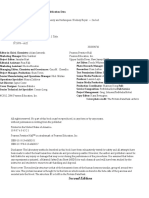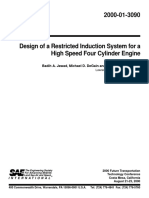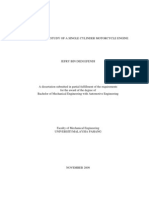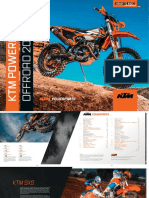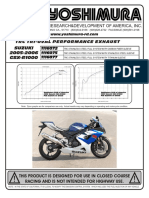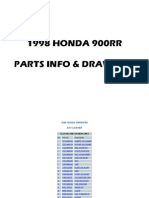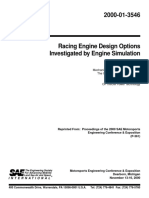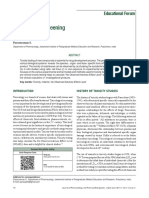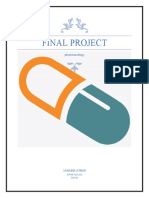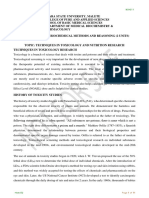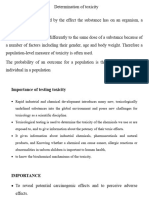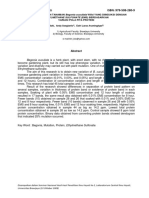Lorkes Method
Lorkes Method
Uploaded by
Wahyu Dian SilvianiCopyright:
Available Formats
Lorkes Method
Lorkes Method
Uploaded by
Wahyu Dian SilvianiOriginal Description:
Copyright
Available Formats
Share this document
Did you find this document useful?
Is this content inappropriate?
Copyright:
Available Formats
Lorkes Method
Lorkes Method
Uploaded by
Wahyu Dian SilvianiCopyright:
Available Formats
Review article ISSN 2321-0125
www.jpbs-online.com
The importance of toxicity testing
David Arome* and Enegide Chinedu
Department of Science Laboratory Technology (Physiology and Pharmacology Technology), University of Jos, Nigeria.
Received on 20 Nov 2013, Accepted on 23 Dec 2013, Available online from 20 Jan 2014
Abstract
Toxicity testing is paramount in the screening of newly developed drugs before it can be used on humans. The essence of
toxicity testing is not just to check how safe a test substance is; but to characterize the possible toxic effects it can
produce. The guiding principles of toxicity testing is to check the effect of the test substances on laboratory animals and
its direct toxic effect on human and secondly, the exposure of laboratory animals to high doses in order to evaluate its
possible hazard on human that are exposed to much lower dose. The present article seeks to highlight the importance of
toxicity testing in the development of therapeutic agents. Toxicity testing is of the following types: acute toxicity studies,
sub-acute toxicity studies and chronic toxicity studies. Toxicity testing employed wide range of test in different species of
animals with long term administration of drug, regular monitoring of physiological, biochemical abnormalities and
detailed post mortem examination at the end of the trial to detect gross or histological abnormalities. Toxic effect of drug
can range from negligible to severe as to preclude further development of the compound. The use of animal in toxicity
testing is most likely to continue for the foreseeable future because of the benefits they offer in examining a whole
functioning organism.
Keywords: Laboratory animals, test substance, toxic effect, toxicity testing
INTRODUCTION Toxicity testing employed wide range of test in different
Toxicity testing is paramount in the screening of newly species of animals with long term administration of drug,
developed drugs before it can be used on humans. regular monitoring of physiological, biochemical
Toxicity testing is the determination of potential hazards abnormalities and detailed post mortem examination at
a test substance may likely produced and the the end of the trial to detect gross or histological
characterization of its action, most of the toxicity testing abnormalities[3]. Dose above therapeutic range are
is carried out on experimental animals[1]. The used in toxicity testing to ascertain the toxic signs of
advantages of using animal models in toxicity testing are action of the drug[2]. The present article seeks to
enormous. These advantages include the possibility of highlight the importance of toxicity testing in the
clearly defined genetic constitution and their amenity to development of therapeutic agents. Toxic effect of drug
controlled exposure, controlled duration of exposure, can range from negligible to severe as to preclude
and the possibility of detailed examination of all tissues further development of the compound. All toxicity study
following necropsy[1]. The information obtained can is supported by; clinical analysis, autophic analysis,
serves as the basis for hazard classification and labeling haematological and haematochemical analysis,
of chemicals in commerce[1]. The essence of toxicity histopathological analysis and statistical presentation
testing is not just to check how safe a test substance is; and data interpretation.
but to characterize the possible toxic effects it can
Importance of toxicity studies
produce. Toxicity testing was given much attention
To establish a dose response curve.
following early 1960s thalidomide catastrophe; with
To ensure safety of new chemicals for use as
thousands of children born worldwide with severe birth
pesticides, drugs, or food additives before they are
defects2. After this incidence many countries of the
registered for general use in industry or doctors clinics.
world have resolved to go for toxicity testing and
To establish the mode of action or mechanism for a
teratogenicity in both sexes so as to prevent further
toxic effect that may have been seen in other studies.
tragedies.
*Corresponding author E - mail: davearome@gmail.com J. Pharm. BioSci. 4(2013) 146-148
147
To produce epidemiological studies to explain Arithmetical method of Reed and Muench.
observations in the population, for instance, the long Arithmetical method of Karbar.
investigation into the association of smoking with lung Lorkes method.
To validate new methods of testing or investigation,
Graphical method of Miller and Tainter
particularly those conducted in vitro rather than in
This method is used in the calculation of any ED50 values.
animals[4].
This involves the administration of same volume of
The two basic principles guiding toxicity test in animals different doses of the test substance to various groups.
To check the effect of the test substances on The animals are divided into five groups of ten animals
laboratory animals and its direct toxic effect on per group. Group one animals receive the vehicle to
human. which the test substance is dissolved while the other
Exposure of laboratory animals to high doses in order groups are given different doses of the test substance. In
to evaluate its possible hazard on human that are this method log doses are plotted on a graph against
exposed to much lower doses[3]. probits of the percentage[2].
Toxicity studies are divided into: Arithmetical method of Reed and Muench
Acute toxicity studies This method is a cumulative analysis of values obtained
This is a short term assessment and evaluation of from the result of the study. It is generally assumed that
potential hazard test substance or consequences of the dead of animals would have been caused by the
single dose of a test substance[5]. Acute toxicity testing administration of higher dose of the test substance. The
may be used in risk assessments of chemicals for cumulative dead and survivors are recorded. The
humans and non-target environmental organisms. Acute percent of survival is calculated and the LD50 is
toxicity study is better described as LD50, which is computed[2].
defined as the dose which kills 50% of animals. LD50 is Karbers Method
used for the estimation of the toxicity of the chemical This method involves the administration of different
agents. Acute toxicity provides guidelines on the dose to doses of test substance to various groups which has five
be use in more prolonged studies and it also provides animals each. The first group of animals receive the
the basis for which other testing program can be design. vehicle in which the test substance is dissolved.
In acute toxicity studies rodent are mostly used because However, other groups receive different doses of the
they are economical and readily available and easy to test substance. The animals in each group receives
handle. This test is carried out in each species of animal specific doses, while increment in dose progresses from
as the same route as intended to be use in treatment[2]. group to group (starting from group 2 which receives the
Importance of acute toxicity testing lowest dose). The interval mean of number of mortality
To identify the target organ of toxicity. recorded in each group and dose difference across the
To provides safety measures and monitoring guild lines groups are key parameters in this method. The lethal
for workers involved in the development and testing of dose is calculated using the arithmetical method of
test substances. Karber which is as follows[7].
To provides information needed for the dose selection LD50= LD100 - ( )
in prolonged toxicity studies. Where LD50 = median lethal dose
To generate data containing the adverse effects of a LD100= least dose required to kill 100%
substance on human, animal health and environment. a= dose differ
To provides the basis for which other testing program b= mean mortality
can be design. n= group population
For academics and regulating purpose; classification,
Lorkes method
labelling and transportation of chemical agents
This test was carried out in two phases.
Methods employed in acute toxicity evaluation Phase I
Graphical method of Miller and Tainter.
Arome et al., J. Pharm. BioSci. 4(2013)146-148
148
In the first phase, nine mice divided into three groups of toxicity testing. New toxicity model under development
three mice each, are given 10, 100, 1000 mg / kg of the include the slug mucosal assay for irritation, transgenic
test substance. After administration of the test animals, the long-term exposure of hepatocyte cultures
substance, observation is made at regular interval to and tissue slices and further development of methods
check for the onset of adverse effect, time to death or for testing for mechanisms of carcinogenicity. The use of
time to recover. The period of observation in this phase I invertebrates, as with the slug for the assessment of eye
is 24 hours. irritation and novel vertebrates such as zebra fish. Stem
Phase II cells remain the great white hope of toxicity testing;
This phase involves the use of three animals divided into their promise remains just that, at the moment, but may
three groups. In this phase, the dose level is either step yet blossom[4].
up or down depending on the outcome of the result
CONCLUSION
obtained from phase I. The animals are administered
Toxicity testing plays a crucial role in ascertaining the
higher dose of 1600, 2900 and 5000 mg/kg. Toxic
toxic effect and characterization of test substance.
symptoms are observed for 24 hours as well as delayed
Toxicity obtained in animal studies occurs with similar
toxic symptoms for 7-14 days. The lethal dose is
incidence and severity in human. The use of animal in
calculated by the formula[6].
toxicity testing is most likely to continue for the
LD50= LD50= (D0D100)
foreseeable future because of the benefits they offer in
D0= highest dose that gave no mortality
examining a whole functioning organism.
D100= lowest dose that produced mortality
REFERENCES
Sub-acute toxicity studies
1. Cunny H, Hodgson E. Toxicity testing. In: Hodgson E,
This study is conducted to determine organs affected by
(ed). A test book on modern toxicology. 3rd
different dose levels. This study access the nature of
edition. A John Wiley & Sons. Inc. Publication. 353-
toxic dose under more realistic situation than the acute
384.
toxicity studies. Three dose levels are normally used[2].
2. Agrawal SS, Paridhavi M. Herbal drug technology.
Dose that is high enough to elicit definite signs of Universities press, India. 2007:607-614.
toxicity but not to kill many of the animals. 3. Klaassen CS. Principle of toxicology and treatment of
Low dose that is expected to induce no toxic effect. poisoning. In: Parker BK, Blumenthal D, Buxton L
Intermediate dose. (eds.). Goodman & Gilmans; manual of
Doses are generally selected on the basis of information pharmacology & therapeutics. McGraw Hill. 2008:
obtained in acute toxicity studies using both LD50 and the 1115-1119.
slope of the dose response curve. The duration of sub- 4. Woolley A. A guide to practical toxicology,
acute toxicity studies depend on intended duration of evaluation, prediction and risk. 2nd ed., Informa
the test substance[2]. Health Care. New York, London. 2008.
Chronic toxicity studies 5. Monosson E. Toxicity testing methods; Encyclopedia
This study is basically to determine the organs affected of earth topics. [updated 2013]. Available from:
and to check whether the drug is potentially http://www.eoearth.org/view/article/1566.73/.
carcinogenic or not. This test extends over a long period 6. Lorkes D. A new approach to practical acute toxicity
of time and it involves large groups of laboratory testing. Achieves of Toxicity 1983;54:275-287.
animals.5 7. Turner R. Acute toxicity: The determination of LD50.
Screening Methods In Pharmacology. Academic
Prospect of new test methods and models
Press, New York. 1965:61- 63.
Integration of new techniques into existing protocols is
definitely going to be a growth area in the future.
Genomics, proteomics and metabonomics[4]. The
introduction of these new toxicity models provides
greater understanding of toxicity in standard laboratory
models and also an important factor in the future of
Arome et al., J. Pharm. BioSci. 4(2013)146-148
You might also like
- 04 ZX 6RR Kit ManualDocument56 pages04 ZX 6RR Kit ManualBrian JohnsonNo ratings yet
- Nitto Legends Car SetupDocument111 pagesNitto Legends Car Setupm4rlon_rcNo ratings yet
- 皮革染色過程的主要問題及移染探討Document74 pages皮革染色過程的主要問題及移染探討高文恩No ratings yet
- Laser Technical Catalogue Including The Pages With PartlistDocument442 pagesLaser Technical Catalogue Including The Pages With PartlistDiego MartinsonNo ratings yet
- Honda Ra 168 e EngineDocument10 pagesHonda Ra 168 e EngineAkshay JoshiNo ratings yet
- 2014 Yz450f PowertunerchartDocument1 page2014 Yz450f PowertunerchartJacob Jack YoshaNo ratings yet
- Iso CatalogosDocument9 pagesIso Catalogosenilson19670% (1)
- Biochemistry Laboratory Modern Theory and Techniques-2nd EdDocument78 pagesBiochemistry Laboratory Modern Theory and Techniques-2nd EdCharles EdwardNo ratings yet
- RET Bellmouth SeptDocument4 pagesRET Bellmouth SeptPravin RajanNo ratings yet
- Honda x8rs Tuning GuideDocument2 pagesHonda x8rs Tuning GuideCarlos Garrido RegateroNo ratings yet
- UntitledDocument154 pagesUntitledKICKERMAN360No ratings yet
- Pin Outs KawasakiDocument5 pagesPin Outs KawasakiErlan BurdaniNo ratings yet
- 2010 - CBR1000RR - HRC - Parts List PDFDocument45 pages2010 - CBR1000RR - HRC - Parts List PDFMartin DeyanovNo ratings yet
- Data LoggerDocument56 pagesData LoggerCiprian PavelescuNo ratings yet
- Water Brake Absorbing DynamometerDocument1 pageWater Brake Absorbing DynamometerShah Fahad Khan100% (1)
- 2000-01-3090 - Design of A Restricted Induction System For A High Speed Four Cylinder EngineDocument8 pages2000-01-3090 - Design of A Restricted Induction System For A High Speed Four Cylinder EngineCaio PaimNo ratings yet
- Valvetronics TechnologyDocument21 pagesValvetronics TechnologyKiran Kumar100% (1)
- Exhaust and CombustionDocument1 pageExhaust and CombustionKhoinguyen NguyenNo ratings yet
- Puma Race Engines PDFDocument8 pagesPuma Race Engines PDFpichaidvNo ratings yet
- Valve Timing Study of A Single Cylinder Motorcycle EngineDocument25 pagesValve Timing Study of A Single Cylinder Motorcycle EnginenicewiseNo ratings yet
- Power PartsDocument101 pagesPower PartsJonAnderCamposNo ratings yet
- Catalogo Ricambi Catalogue Pieces Ersatzteile - Katalog CatalogoDocument86 pagesCatalogo Ricambi Catalogue Pieces Ersatzteile - Katalog CatalogoOliverNo ratings yet
- Pistons Catalogue 2009 (V2.2 Compact)Document28 pagesPistons Catalogue 2009 (V2.2 Compact)Mr.JohnNo ratings yet
- MSA Rule Book 2013 PDFDocument76 pagesMSA Rule Book 2013 PDFjohnknight000No ratings yet
- Drag Illustrated Magazine. January 2011Document172 pagesDrag Illustrated Magazine. January 2011Northpolestar100% (1)
- Ford Intake Ports ReportDocument30 pagesFord Intake Ports ReportgosculptorNo ratings yet
- Suzuki GSX-R1000 2005-2006Document6 pagesSuzuki GSX-R1000 2005-2006Mr. TNo ratings yet
- SU Needle Types For Which CarsDocument2 pagesSU Needle Types For Which CarsBennie Barnard100% (1)
- Stihl Ts 410 420 Owners Instruction ManualDocument112 pagesStihl Ts 410 420 Owners Instruction ManualJS100% (1)
- 04 EN 3.0 A4webDocument2 pages04 EN 3.0 A4webDaniel SilvaNo ratings yet
- Mini and Metro Engine Numbers CCDocument11 pagesMini and Metro Engine Numbers CCFrancesco Matteoli0% (1)
- VFR400 Engine Mods-R OliverDocument5 pagesVFR400 Engine Mods-R OliverAndrés Nuñez0% (1)
- Novice Handbook (By Steve Clark)Document36 pagesNovice Handbook (By Steve Clark)Michael100% (1)
- IC Engine Lab ManualDocument11 pagesIC Engine Lab ManualVyankat Dev Singh100% (1)
- Combustion Chamber Sae-Ref PaperDocument9 pagesCombustion Chamber Sae-Ref PaperAshokNo ratings yet
- rgv250 1989Document52 pagesrgv250 1989felipe baezaNo ratings yet
- Honda 900RR Parts Info & Drawings - 1998Document119 pagesHonda 900RR Parts Info & Drawings - 1998cbrmatos100% (1)
- Iav Ottomotorisches Klopfen Ans PDFDocument449 pagesIav Ottomotorisches Klopfen Ans PDFengrsurifNo ratings yet
- Dynomation - Users ManualDocument289 pagesDynomation - Users ManualisttNo ratings yet
- Design Steps For Intake & Exhaust Systems: Acoustic Theory To Maximize Volumetric EfficeincyDocument22 pagesDesign Steps For Intake & Exhaust Systems: Acoustic Theory To Maximize Volumetric EfficeincyKushal DhokareNo ratings yet
- 2000-01-3546BLAIR - MotoGP Engine Design 900cc TripleDocument16 pages2000-01-3546BLAIR - MotoGP Engine Design 900cc TripleT SmiNo ratings yet
- Performance of IC's EngineDocument45 pagesPerformance of IC's EngineNandhakumarNo ratings yet
- Six Stroke EngineDocument36 pagesSix Stroke EngineAmandeep Tanwar100% (2)
- Project Plan For Upgrading Motorcycle (Yamaha R15)Document4 pagesProject Plan For Upgrading Motorcycle (Yamaha R15)Ravi SinghNo ratings yet
- Grand Prix Motorradmotoren Design Alternatives For MotoGP Engines Gordon P. BlairDocument14 pagesGrand Prix Motorradmotoren Design Alternatives For MotoGP Engines Gordon P. BlairLuizGustavoVicenteNo ratings yet
- nsf250r 2012 Owners Manual English PDFDocument300 pagesnsf250r 2012 Owners Manual English PDFDavidNo ratings yet
- Farm Engines and How to Run Them The Young Engineer's GuideFrom EverandFarm Engines and How to Run Them The Young Engineer's GuideNo ratings yet
- The Importance of Toxicity Testing: October 2018Document4 pagesThe Importance of Toxicity Testing: October 2018প্রণয় সাহা প্রান্ময়No ratings yet
- Toxicological Screening: Educational ForumDocument6 pagesToxicological Screening: Educational ForumeyobNo ratings yet
- Unit-5 - PHARMACOLOGY IIIDocument38 pagesUnit-5 - PHARMACOLOGY IIIShantanu RewatkarNo ratings yet
- Toxicology Research GateDocument6 pagesToxicology Research GateMonalica ChauhanNo ratings yet
- Toxicological Approach To Drug Development: Prepared By: Dr. C. Suhas ReddyDocument49 pagesToxicological Approach To Drug Development: Prepared By: Dr. C. Suhas Reddyparminder.nain29No ratings yet
- Toxicological ScreeningDocument11 pagesToxicological Screeningkunalprabhu148100% (1)
- Pharma Sahabia Athar dptm-f18-143 (dpt5b) PharmaDocument8 pagesPharma Sahabia Athar dptm-f18-143 (dpt5b) PharmaSahabiaNo ratings yet
- BCH413 2019-20 Harmattan 2Document11 pagesBCH413 2019-20 Harmattan 2idriscognitoleadsNo ratings yet
- Advances in Acute Toxicity Testing: Strengths, Weaknesses and Regulatory AcceptanceDocument8 pagesAdvances in Acute Toxicity Testing: Strengths, Weaknesses and Regulatory AcceptanceMariel GentilesNo ratings yet
- walum-1998-acute-oral-toxicity (1)Document7 pageswalum-1998-acute-oral-toxicity (1)thuynguyen.le2002No ratings yet
- P12 M32 TextDocument21 pagesP12 M32 TextArya MahapatraNo ratings yet
- Non Clinical StudiesDocument7 pagesNon Clinical Studiesvipinkv99No ratings yet
- Animal Clinical ChemistryDocument231 pagesAnimal Clinical ChemistryAngel GarciaNo ratings yet
- Toxicology in The Drug Discovery and Development Process: UNIT 10.3Document35 pagesToxicology in The Drug Discovery and Development Process: UNIT 10.3Nilabh RanjanNo ratings yet
- Acute Toxicity StudyDocument25 pagesAcute Toxicity StudyAmmar SarwarNo ratings yet
- Methods To Test Toxicity 2024Document23 pagesMethods To Test Toxicity 2024daniel silaNo ratings yet
- IOS-MAT-0076 (AA-300587-9) - Sedo VinaDocument19 pagesIOS-MAT-0076 (AA-300587-9) - Sedo VinaVo Phi LongNo ratings yet
- Margdarshak For JEE AdvancedDocument21 pagesMargdarshak For JEE AdvancedAshutosh Garg67% (3)
- The Earliest Use of Lime and Gypsum Mortars in CyprusDocument11 pagesThe Earliest Use of Lime and Gypsum Mortars in CyprusIS AANo ratings yet
- Handbook On Herbal Products Medicines - Cosmetics - Toiletries - Perfumes) 2 Vols.Document7 pagesHandbook On Herbal Products Medicines - Cosmetics - Toiletries - Perfumes) 2 Vols.tuanhuy5633% (3)
- Solutions - DPP 05 (Of Lec 09) - Lakshya JEE 2025Document3 pagesSolutions - DPP 05 (Of Lec 09) - Lakshya JEE 2025testacount3258No ratings yet
- AMPT Digital NotesDocument85 pagesAMPT Digital NotesDeepika PandeyNo ratings yet
- Pillow Block FBJ ChumacerasDocument62 pagesPillow Block FBJ ChumacerasJulián GarcíaNo ratings yet
- Metamorphic PetrologyDocument1 pageMetamorphic PetrologyShivendra Pratap SinghNo ratings yet
- Literature Review of Hydrogen Production, Storage, Distribution, and Utilization Technologies: Executive SummaryDocument4 pagesLiterature Review of Hydrogen Production, Storage, Distribution, and Utilization Technologies: Executive SummaryVictor AtilolaNo ratings yet
- Dzung Quat RefineryDocument67 pagesDzung Quat Refinerytungxuanbr100% (1)
- Heat Transfer and Expansion NotesDocument8 pagesHeat Transfer and Expansion NotesmelissaNo ratings yet
- Resonance Chemistry DPP 6 (Advanced)Document11 pagesResonance Chemistry DPP 6 (Advanced)Anurag1210701067% (6)
- Thermal Resistance of Air CavityDocument1 pageThermal Resistance of Air CavityAhmed MostafaNo ratings yet
- Resume of Sudhir MhetreDocument2 pagesResume of Sudhir MhetreSudhirNo ratings yet
- Ethyl CelluloseDocument4 pagesEthyl CelluloseRisniNo ratings yet
- Umbi Porang PDFDocument7 pagesUmbi Porang PDFFatoni NugrohoNo ratings yet
- Chapter 19: The Nucleus: A Chemist's ViewDocument13 pagesChapter 19: The Nucleus: A Chemist's ViewIron ManNo ratings yet
- Keanekaragaman Tanaman Begonia Cucullata Willd Yang Diinduksi Dengan Ethylmethane Sulfonate (Ems) BerdasarkanDocument8 pagesKeanekaragaman Tanaman Begonia Cucullata Willd Yang Diinduksi Dengan Ethylmethane Sulfonate (Ems) BerdasarkanSti FaniNo ratings yet
- PaintsDocument28 pagesPaintsPragati ShewaleNo ratings yet
- 0400 Amerlock 400 PDS March 08Document2 pages0400 Amerlock 400 PDS March 08Kalaiyazhagan ElangeeranNo ratings yet
- Dimensionless Presentation of Performance Data For Fans and BlowersDocument5 pagesDimensionless Presentation of Performance Data For Fans and BlowersNg KhanhNo ratings yet
- National Institute of Technology, Raipur Chemical Engineering DepartmentDocument10 pagesNational Institute of Technology, Raipur Chemical Engineering DepartmentAarva RoyNo ratings yet
- D 4326 - 01 RdqzmjytukveDocument5 pagesD 4326 - 01 RdqzmjytukveRuben YoungNo ratings yet
- Alkalin Wash CleanerDocument6 pagesAlkalin Wash CleanerAbumuwahid FirmansyahNo ratings yet
- Drug Designand Discovery DR MKotbDocument33 pagesDrug Designand Discovery DR MKotbIT alokNo ratings yet
- Soil FormationDocument16 pagesSoil FormationSheryl R. ValienteNo ratings yet
- Iprc Saint Joseph-Concrete TechnologyDocument46 pagesIprc Saint Joseph-Concrete TechnologyEng Bagaragaza RomualdNo ratings yet





